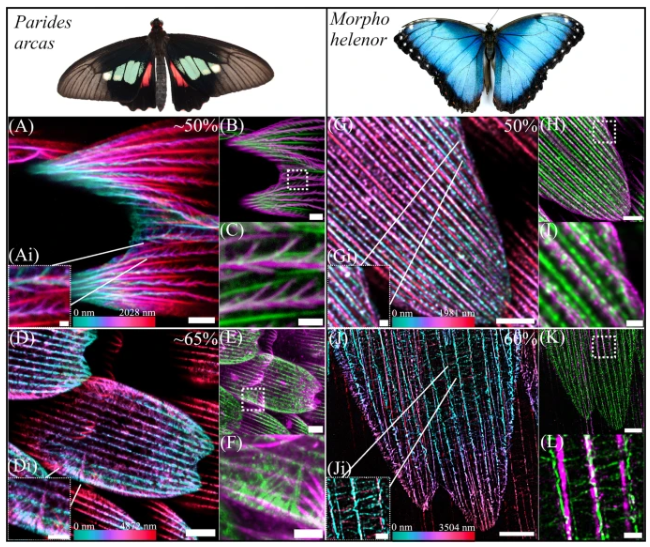The bright rainbow of colours we see adorned on the wings of butterflies are highly important in matters of successful survival for their species. However, the shades we observe are not always pigments at all. Instead, many butterflies use structures within their wing scales that reflect certain colours of light back, making them appear iridescent. There is good reason for this – in a dark forest, these colours would be much brighter than a pigmented equivalent, and it also helps avoid the colours fading after prolonged sun exposure.
While it is broadly understood how these optical scales function, it’s more difficult to pinpoint how they are formed, and what parts of this initial process differ from non-iridescent scales. A collaboration between the Central Laser Facility and the University of Sheffield has set out to investigate exactly this by tracing early scale development using super-resolution microscopy techniques.
The team studied the Sara longwing (Heliconius sara), a butterfly that has both bold, blue-appearing iridescent scales, and non-iridescent black scales. This allowed them to compare the two types of scales throughout this study. They found that iridescent and non-iridescent scales actually have very similar structures, but iridescent scales tend to be smaller, with large and more densely packed ridges to help reflect light.

Image credit: The actin cytoskeleton plays multiple roles in structural colour formation in butterfly wing scales | Nature Communications)
The group then turned to a particular protein found in butterflies – actin. Actin is thought to be incredibly important in scale production and shaping, working in bundles throughout the wing scales. They looked at scales from 25% to 62.5% in the butterfly’s pupation to understand how this protein is distributed during this stage. Iridescent scales were seen to have thinner bundles of actin and reduced spacing between bundles – very similar to what is seen with the respective scale ridges. This implies that the presence of actin is directly linked to scale ridge development.
Actin forms a cytoskeleton in the growing scale cells that helps to develop crucial elements of the structure such as ‘ribs’, that connect the ridges, and ‘fingers’ at the tips of the scales. To further understand its role in colour production, the team disrupted actin at 50% pupation. When this was done, they observed darker wings with reduced reflectivity compared to the control samples that had not been disrupted. This is further evidence of the large role actin plays in creating iridescent butterfly scale structures.

Image
credit: Esther Garcia, Central Laser Facility.
The study concludes that actin essentially serves as a temporary map or scaffold that shapes structural development, and therefore colour. This can be likened to the laying out and pinning stage of dressmaking, and in much the same way the pins can be removed, the actin is broken down, leaving the precise nanostructures that support iridescent colour.
Studies like that conducted by the Sheffield and CLF team are helping us to understand how cells, and particularly these nanostructures, are formed in nature. This could be instrumental in developing a range of new technologies inspired by nature. Structural-based colour is already used in a variety of places, including on bank notes to distinguish them from counterfeits as it cannot be reproduced by printing! In the future, nanostructures may provide an alternative to toxic substances used to colour materials, making them safer and better for the environment. These colours would be long-lasting, avoiding the corrosion and bleaching many of our current methods see over time. The sensitivity of nanostructures to different wavelengths of light may also make them useful in sensors to make faster computers, and some even have antibacterial properties that could be ideal for medical instrumentation. By studying the colour of butterflies, it is clear that there is much we can learn from the world around us in our advancement of science.
Read the full paper at: The actin cytoskeleton plays multiple roles in structural colour formation in butterfly wing scales | Nature Communications
